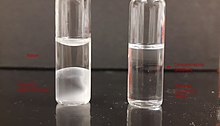Polypropylene glycol

| |
| Names | |
|---|---|
| IUPAC name
2-(2-hydroxypropoxy)propan-1-ol
| |
| Identifiers | |
| |
| ECHA InfoCard | 100.105.547 |
| UNII | |
CompTox Dashboard (EPA)
|
|
| Properties | |
| C3H6O2 | |
| Molar mass | 76.01 (repeat unit), mass of polymer variable |
Except where otherwise noted, data are given for materials in their standard state (at 25 °C [77 °F], 100 kPa). | |
| Infobox references | |
Polypropylene glycol or polypropylene oxide is the polymer of propylene glycol. Chemically it is a polyether, and, more generally speaking, it's a polyalkylene glycol (PAG) H S Code 3907.2000. The term polypropylene glycol or PPG is reserved for low to medium range molar mass polymer when the nature of the end-group, which is usually a hydroxyl group, still matters. The term "oxide" is used for high molar mass polymer when end-groups no longer affect polymer properties. Between 60 and 70% of propylene oxide is converted to polyether polyols by the process called alkoxylation.[1]
Polymerization[]
Polypropylene glycol is produced by ring-opening polymerization of propylene oxide. The initiator is an alcohol and the catalyst a base, usually potassium hydroxide. When the initiator is ethylene glycol or water the polymer is linear. With a multifunctional initiator like glycerine, pentaerythritol or sorbitol the polymer branches out.

Conventional polymerization of propylene oxide results in an atactic polymer.
Properties[]
PPG has many properties in common with polyethylene glycol. The polymer is a liquid at room temperature. Solubility in water decreases rapidly with increasing molar mass. Secondary hydroxyl groups in PPG are less reactive than primary hydroxyl groups in polyethylene glycol. PPG is less toxic than PEG, so biotechnologicals are now produced in PPG.

Uses[]
PPG is used in many polyurethane formulations.
PPG is used as a surfactant, wetting agent, dispersant in leather finishing.
PPG is also employed as a tuning reference and calibrant in mass spectrometry.
PPG is used as a primary ingredient in the making of paintballs.
References[]
- ^ Adam, Norbert; et al. "Polyurethanes". Ullmann's Encyclopedia of Industrial Chemistry. Weinheim: Wiley-VCH. doi:10.1002/14356007.a21_665.pub2.
- Polyethers